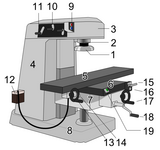Milling machines may be manually operated, mechanically automated, or digitally automated via computer numerical control (CNC). Milling machines can perform a vast number of operations, from simple (e.g., slot and keyway cutting, planing, drilling) to complex (e.g., contouring, diesinking). Cutting fluid is often pumped to the cutting site to cool and lubricate the cut and to wash away the resulting swarf.
Comparing vertical with horizontal
In the vertical mill the spindle axis is vertically oriented. Milling cutters are held in the spindle and rotate on its axis. The spindle can generally be extended (or the table can be raised/lowered, giving the same effect), allowing plunge cuts and drilling. There are two subcategories of vertical mills: the bedmill and the turret mill. Turret mills, like the ubiquitous Bridgeport, are generally smaller than bedmills, and are considered by some to be more versatile. In a turret mill the spindle remains stationary during cutting operations and the table is moved both perpendicular to and parallel to the spindle axis to accomplish cutting. In the bedmill, however, the table moves only perpendicular to the spindle's axis, while the spindle itself moves parallel to its own axis. Also of note is a lighter machine, called a mill-drill. It is quite popular with hobbyists, due to its small size and lower price. These are frequently of lower quality than other types of machines, however.
A horizontal mill has the same sort of x–y table, but the cutters are mounted on a horizontal arbor (see Arbor milling) across the table. A majority of horizontal mills also feature a +15/-15 degree rotary table that allows milling at shallow angles. While endmills and the other types of tools available to a vertical mill may be used in a horizontal mill, their real advantage lies in arbor-mounted cutters, called side and face mills, which have a cross section rather like a circular saw, but are generally wider and smaller in diameter. Because the cutters have good support from the arbor, quite heavy cuts can be taken, enabling rapid material removal rates. These are used to mill grooves and slots. Plain mills are used to shape flat surfaces. Several cutters may be ganged together on the arbor to mill a complex shape of slots and planes. Special cutters can also cut grooves, bevels, radii, or indeed any section desired. These specialty cutters tend to be expensive. Simplex mills have one spindle, and duplex mills have two. It is also easier to cut gears on a horizontal mill.
The vertical-vs-horizontal distinction seems trivial from some viewpoints; after all, changing the mounting of a machine part, accessory, or workpiece by 90° is often a straightforward matter. Yet the distinction has recurrently held more importance than one might expect, for similar reasons that the horizontal-lathe-vs-vertical-lathe distinction has mattered. The shape and size of workpieces and the number of sides that they require machining on can make one type of machine more practical than another.
In the pre-NC era, horizontal milling machines appeared first, because they evolved by putting milling tables under lathe-like headstocks. Vertical mills appeared in subsequent decades, and accessories in the form of add-on heads to change horizontal mills to vertical mills (and later vice versa) have been commonly used. Work in which the spindle's axial movement is normal to one plane, with an endmill as the cutter, lends itself to a vertical mill, where the operator can stand before the machine and have easy access to the cutting action by looking down upon it. Thus most diesinking work has always favored a vertical mill. The heavier the workpiece, the more likely one is to want it to sit directly on the table rather than being mounted indirectly on an angle plate (or rotary table or indexing head perpendicular to the table), just as short, heavy workpieces are easier to set up on a vertical lathe or boring mill (and remove later) than on the headstock of a horizontal-axis lathe. Even in the CNC era, a heavy workpiece needing machining on multiple sides lends itself to a horizontal machining center, while diesinking lends itself to a vertical one.
Source: Wikipedia


Saya nak jual ni
ReplyDeletehttps://forum.lowyat.net/topic/3517627
Siapa minat hubungi saya